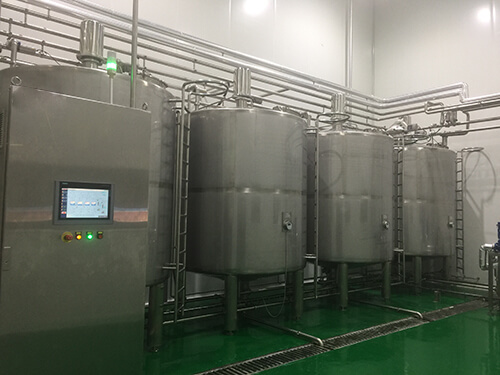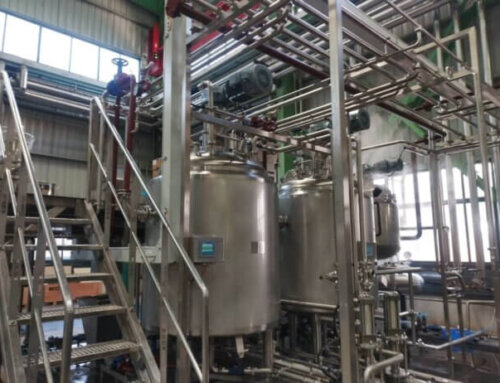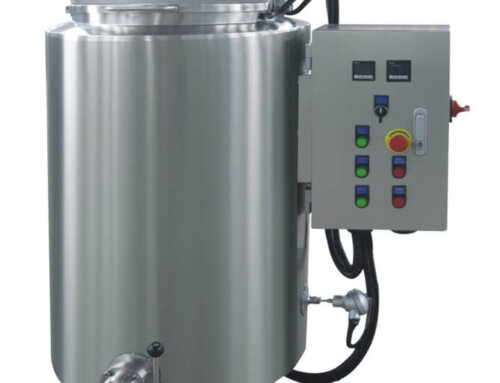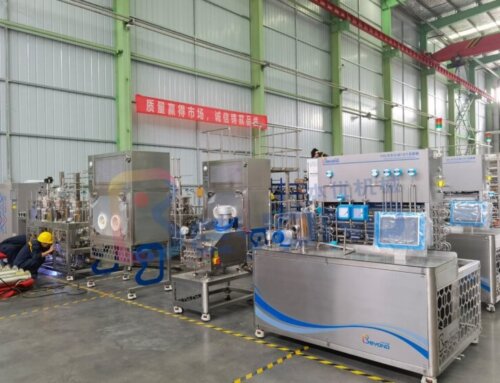Overview Of Margarine Processing Line
Margarine is an oil-water mixed product prepared by adding vegetable oil or animal oil, water and seasoning to replace the natural cream obtained from milk.
Margarine and related products contain a water phase and oil phase, and can therefore be characterized as a water-in-oil (W/O) emulsion, in which the water phase is finely dispersed in a continuous fatty phase in the form of droplets. Depending on the application of the product, the composition of the fatty phase and the manufacturing process is selected accordingly. Modern manufacturing facilities for margarine and related products typically include various storage tanks as well as an emulsifier, water phase and emulsion preparation tanks as part of a crystallization facility; the size and number of tanks are calculated based on the plant’s capacity and product mix. The facility also includes a pasteurization unit and a remelting facility.
The margarine production process includes two major parts: raw material preparation and margarine cooling and crystallization. The previous process is the mixing, emulsification and metering of the oil phase and the water phase; The post process is continuous cooling, emulsification, and product packaging, which can be divided into five stages: blending of raw and auxiliary materials, emulsification, flash cooling and kneading, packaging, and aging.
The capacity of the margarine processing line is from 200L/H to 5000L/H. And the end products can be packed into plastic cans, cartons or paper wrapping.
The margarine processing machines include a water phase tank, oil phase tank, emulsifying tank, plate pasteurizer system, SSHE flash cooling machine, flooded refrigerant evaporative cooling system, margarine kneading machine, crystallization equipment, filling and packing system. All the machines are SUS304/316L and meet the food hygiene requirements.

Margarine Processing Line Steps
Oil phase and water phase preparation system
The water phase is usually prepared in water phase tank. The water should meet drinking quality standards. If the quality of drinking water cannot be guaranteed, the water can be pretreated, for example: UV light or filtration systems. In addition to water, the water phase may be composed of salt or brine, milk proteins (edible margarine and low-fat spreads), sugar (puff pastry), stabilizers (low-fat and low-fat spreads), preservatives and Water-soluble flavoring agent composition.
The main component in the fat phase, the fat mixture, usually consists of a mixture of different fats and oils. In order to obtain margarine with the desired properties and functions, the ratio of fat and oil in the fat mixture is decisive for the properties of the final product. Various fats and oils, whether fat blends or single oils, are stored in storage tanks that are usually placed outside production facilities. They are kept at a stable storage temperature above the melting point of the fat and under agitation to avoid fat fractionation and ease of handling.
In addition to the fat mixture, the fat phase usually consists of small amounts of fat-soluble ingredients, such as emulsifiers, lecithin, flavors, colors, and antioxidants. These minor components are dissolved in the fat mixture before the water phase prior to the emulsification process.

Emulsification preparation system
Emulsions are prepared by transferring various oils or fat mixtures into an emulsion tank. Typically, the high-melting fat or fat mixture is added first, followed by the low-melting fat and liquid oil. To complete the preparation of the fat phase, emulsifiers and other oil-soluble minor ingredients are added to the fat mixture. When all components of the fatty phase have been properly mixed, the water phase is added and an emulsion is formed with vigorous but controlled mixing.
There are two methods to meter and dose the ingredients, namely flowmeter dosing system and the weighing sensor system.
The flow meter system is based on batch emulsion preparation, where the various phases and ingredients are measured by mass flow meters as they are transferred from the individual phase preparation tanks to the emulsion tank. The accuracy of the system is +/-0.3%. The system is characterized by its insensitivity to external influences such as vibration and dirt.
Weigh tank systems are similar to flow meter systems based on batch emulsion preparation. Here, the amounts of ingredients and phases are added directly to the emulsion tank, which is mounted on a load cell that controls the amount added to the tank.
Typically, a two-tank system is used for the preparation of emulsions so that the production line can be run continuously. Each tank is used as a preparation and buffer tank (emulsion tank), so the crystallization line will be fed from one tank and a new batch will be prepared in another tank. Preparing the emulsion in one tank and transfers to a buffer tank when ready is also an option, this system is called a premix/buffer system.

Pasteurizing system
The emulsion is typically pumped continuously from a buffer tank through a plate heat exchanger (PHE) for pasteurization before entering the crystallization line.
For full-fat products, PHE is usually used. For low-fat versions and heat-sensitive emulsions (such as those with high protein content) where the emulsion is expected to have a relatively high viscosity, a shell and tube heat exchanger is recommended. Pasteurization has several advantages, it ensures inhibition of bacterial and other microorganisms’ growth, thereby improving the microbial stability of the emulsion.
After preparing the emulsion at 45-55°C, the pasteurization process involves heating and holding the emulsion at 75-85°C for 16 seconds. It is then cooled to a temperature of 45-55°C. The final temperature depends on the melting point of the fat phase: the higher the melting point, the higher the temperature.

Margarine flash cooling, crystallization and kneading system
The emulsion is pumped to the crystallization line by a high-pressure piston pump. Crystallization lines for the production of margarine and related products typically consist of high-pressure scraped-surface heat exchangers(SSHE) cooled by ammonia or Freon-type cooling media. Kneaders and/or intermediate crystallizers are often included in the production line to add additional kneading intensity and time to the production of end products. The rest tube is the last step in the crystallization line and is only included if the product is packaged.
The high-pressure scraped surface heat exchanger is the core equipment of the crystallization line, where the emulsion is flash cooled and crystallized on the inner surface of the cooling tube. The emulsion is effectively scraped off by the rotating scraper, so the emulsion is simultaneously cooled and kneaded. When the fat in the emulsion crystallizes, the fat crystals form a three-dimensional network that encases the water droplets and liquid oil, resulting in a product with plastic semi-solid properties. Depending on the type of product to be manufactured and the type of fat used for the specific product, the configuration of the crystallization line (i.e. the sequence of scraped surface heat exchangers and kneaders) can be adjusted to provide the best configuration for the specific product.
Since crystallization lines often produce more than one specific fat product, flash cooling typically consists of two or more cooling sections or cooling tubes to meet the requirements of flexible crystallization lines. Flexibility is required when producing different crystalline fat products for various fat blends, as the crystalline properties of the blends may vary from one blend to the next.
The system is equipped with password protection and has a historical data recording function to record the parameters involved in the margarine processing line. The data records include the capacity and output of the high-pressure pump (l/h and back pressure), product temperature during crystallization (including pasteurization process), cooling temperature (or cooling medium pressure) of SSHE, speed of SSHE and pin rotor machine As well as motor loads running high-pressure pumps, SSHE and pin rotor machines.

CIP cleaning system
CIP cleaning equipment is also part of modern margarine processing line, as margarine production equipment should be cleaned regularly. For traditional margarine products, once a week is the normal cleaning interval. However, for sensitive products such as low-fat (high water content) and/or high-protein products, shorter CIP intervals are recommended.
In principle, two CIP systems are used: CIP plants that use the cleaning medium only once or recommended CIP plants that operate through a buffered solution of the cleaning medium, in which media such as lye, acid and/or disinfectant are returned to a separate After the CIP tank is used. The latter method is preferred because it represents an environmentally friendly solution and economical solution in terms of consumption of cleaning agents and thus reducing the cost of these cleaning agents.





